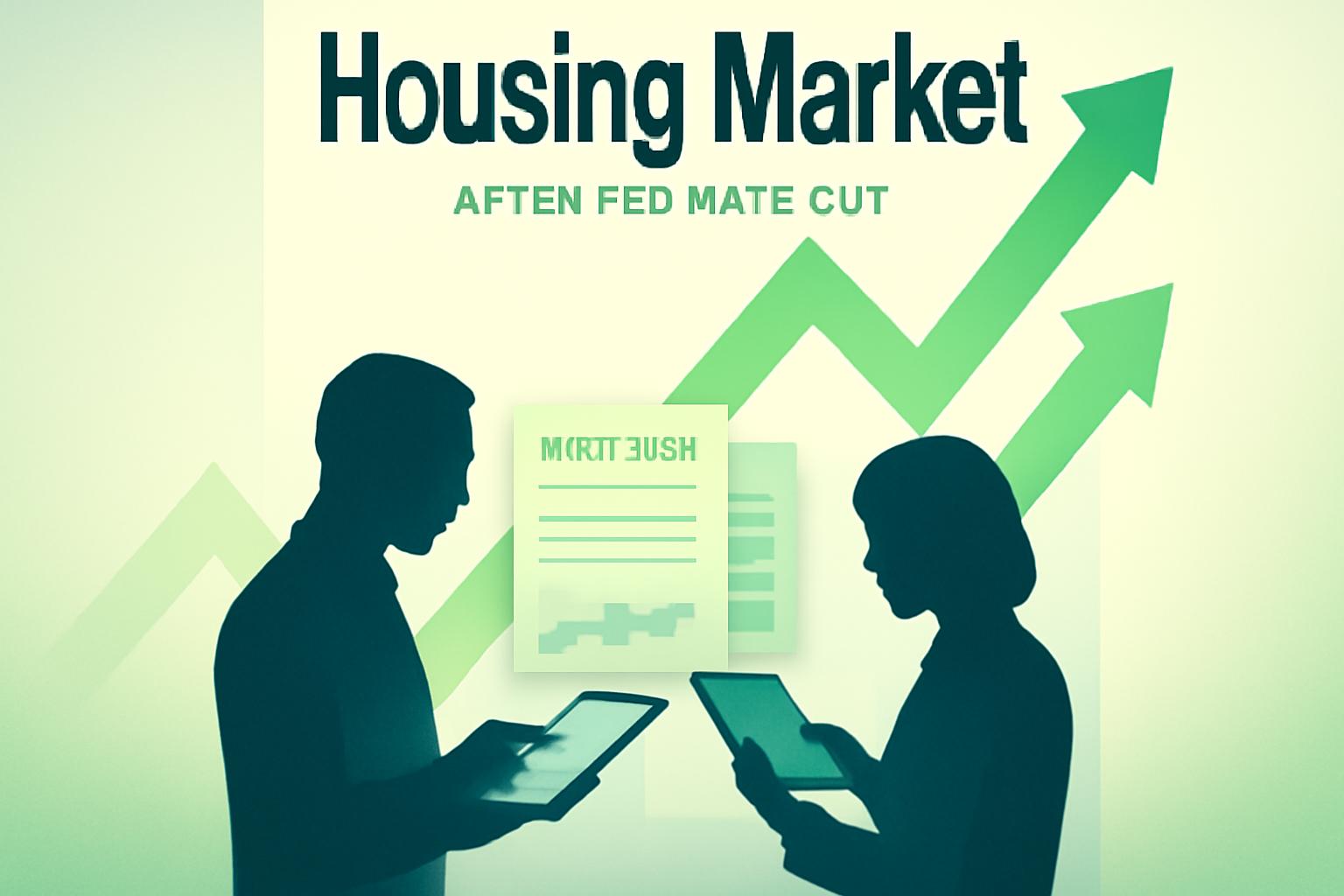Today’s ARM borrowers typically have strong credit profiles and often seek larger loan amounts. Stringent underwriting standards limit ARM accessibility, distinguishing them from the looser credit practices that contributed to the subprime crisis.
FinOracleAI — Market View
The Fed’s recent rate cut has injected cautious optimism into the housing market by lowering borrowing costs. Adjustable-rate mortgages, offering substantially lower initial rates than fixed loans, are gaining traction as a strategic option for qualified buyers. However, the inherent risk of rate adjustments post-initial period necessitates prudent financial planning.
- Opportunities: Lower upfront payments with ARMs improve affordability for buyers in a high-rate environment.
- Risks: Potential for increased payments after initial fixed period if rates rise.
- Market Impact: Increased ARM applications signal shifting borrower strategies amid fluctuating rate forecasts.
- Credit Quality: Current stringent underwriting reduces risk of borrower default compared to past ARM cycles.
- Refinancing Potential: Buyers planning to refinance or sell before rate adjustments can mitigate risk exposure.
Impact: The Fed rate cut enhances mortgage affordability, making ARMs a viable but nuanced option for homebuyers. Market participants should weigh the benefits of lower initial rates against potential future rate increases.
As a result, ARMs are often best suited for buyers who plan to refinance or sell before the adjustment period begins, mitigating exposure to potential rate increases.
Choosing an ARM requires careful consideration of one’s financial horizon and risk tolerance.
Qualification Standards and Borrower Profile
Today’s ARM borrowers typically have strong credit profiles and often seek larger loan amounts. Stringent underwriting standards limit ARM accessibility, distinguishing them from the looser credit practices that contributed to the subprime crisis.
FinOracleAI — Market View
The Fed’s recent rate cut has injected cautious optimism into the housing market by lowering borrowing costs. Adjustable-rate mortgages, offering substantially lower initial rates than fixed loans, are gaining traction as a strategic option for qualified buyers. However, the inherent risk of rate adjustments post-initial period necessitates prudent financial planning.
- Opportunities: Lower upfront payments with ARMs improve affordability for buyers in a high-rate environment.
- Risks: Potential for increased payments after initial fixed period if rates rise.
- Market Impact: Increased ARM applications signal shifting borrower strategies amid fluctuating rate forecasts.
- Credit Quality: Current stringent underwriting reduces risk of borrower default compared to past ARM cycles.
- Refinancing Potential: Buyers planning to refinance or sell before rate adjustments can mitigate risk exposure.
Impact: The Fed rate cut enhances mortgage affordability, making ARMs a viable but nuanced option for homebuyers. Market participants should weigh the benefits of lower initial rates against potential future rate increases.
Joel Kan warns, “Problems arise if there is a payment adjustment and the borrower is not equipped to handle that change in payment.”
As a result, ARMs are often best suited for buyers who plan to refinance or sell before the adjustment period begins, mitigating exposure to potential rate increases.
Choosing an ARM requires careful consideration of one’s financial horizon and risk tolerance.
Qualification Standards and Borrower Profile
Today’s ARM borrowers typically have strong credit profiles and often seek larger loan amounts. Stringent underwriting standards limit ARM accessibility, distinguishing them from the looser credit practices that contributed to the subprime crisis.
FinOracleAI — Market View
The Fed’s recent rate cut has injected cautious optimism into the housing market by lowering borrowing costs. Adjustable-rate mortgages, offering substantially lower initial rates than fixed loans, are gaining traction as a strategic option for qualified buyers. However, the inherent risk of rate adjustments post-initial period necessitates prudent financial planning.
- Opportunities: Lower upfront payments with ARMs improve affordability for buyers in a high-rate environment.
- Risks: Potential for increased payments after initial fixed period if rates rise.
- Market Impact: Increased ARM applications signal shifting borrower strategies amid fluctuating rate forecasts.
- Credit Quality: Current stringent underwriting reduces risk of borrower default compared to past ARM cycles.
- Refinancing Potential: Buyers planning to refinance or sell before rate adjustments can mitigate risk exposure.
Impact: The Fed rate cut enhances mortgage affordability, making ARMs a viable but nuanced option for homebuyers. Market participants should weigh the benefits of lower initial rates against potential future rate increases.
Despite their appeal, ARMs carry inherent risks. After the fixed initial period, the interest rate adjusts according to prevailing market conditions. Should rates rise, borrowers may face substantially higher monthly payments compared to fixed-rate loans.
Joel Kan warns, “Problems arise if there is a payment adjustment and the borrower is not equipped to handle that change in payment.”
As a result, ARMs are often best suited for buyers who plan to refinance or sell before the adjustment period begins, mitigating exposure to potential rate increases.
Choosing an ARM requires careful consideration of one’s financial horizon and risk tolerance.
Qualification Standards and Borrower Profile
Today’s ARM borrowers typically have strong credit profiles and often seek larger loan amounts. Stringent underwriting standards limit ARM accessibility, distinguishing them from the looser credit practices that contributed to the subprime crisis.
FinOracleAI — Market View
The Fed’s recent rate cut has injected cautious optimism into the housing market by lowering borrowing costs. Adjustable-rate mortgages, offering substantially lower initial rates than fixed loans, are gaining traction as a strategic option for qualified buyers. However, the inherent risk of rate adjustments post-initial period necessitates prudent financial planning.
- Opportunities: Lower upfront payments with ARMs improve affordability for buyers in a high-rate environment.
- Risks: Potential for increased payments after initial fixed period if rates rise.
- Market Impact: Increased ARM applications signal shifting borrower strategies amid fluctuating rate forecasts.
- Credit Quality: Current stringent underwriting reduces risk of borrower default compared to past ARM cycles.
- Refinancing Potential: Buyers planning to refinance or sell before rate adjustments can mitigate risk exposure.
Impact: The Fed rate cut enhances mortgage affordability, making ARMs a viable but nuanced option for homebuyers. Market participants should weigh the benefits of lower initial rates against potential future rate increases.
Despite their appeal, ARMs carry inherent risks. After the fixed initial period, the interest rate adjusts according to prevailing market conditions. Should rates rise, borrowers may face substantially higher monthly payments compared to fixed-rate loans.
Joel Kan warns, “Problems arise if there is a payment adjustment and the borrower is not equipped to handle that change in payment.”
As a result, ARMs are often best suited for buyers who plan to refinance or sell before the adjustment period begins, mitigating exposure to potential rate increases.
Choosing an ARM requires careful consideration of one’s financial horizon and risk tolerance.
Qualification Standards and Borrower Profile
Today’s ARM borrowers typically have strong credit profiles and often seek larger loan amounts. Stringent underwriting standards limit ARM accessibility, distinguishing them from the looser credit practices that contributed to the subprime crisis.
FinOracleAI — Market View
The Fed’s recent rate cut has injected cautious optimism into the housing market by lowering borrowing costs. Adjustable-rate mortgages, offering substantially lower initial rates than fixed loans, are gaining traction as a strategic option for qualified buyers. However, the inherent risk of rate adjustments post-initial period necessitates prudent financial planning.
- Opportunities: Lower upfront payments with ARMs improve affordability for buyers in a high-rate environment.
- Risks: Potential for increased payments after initial fixed period if rates rise.
- Market Impact: Increased ARM applications signal shifting borrower strategies amid fluctuating rate forecasts.
- Credit Quality: Current stringent underwriting reduces risk of borrower default compared to past ARM cycles.
- Refinancing Potential: Buyers planning to refinance or sell before rate adjustments can mitigate risk exposure.
Impact: The Fed rate cut enhances mortgage affordability, making ARMs a viable but nuanced option for homebuyers. Market participants should weigh the benefits of lower initial rates against potential future rate increases.
However, ARMs have not regained the prominence they held during the mid-2000s subprime mortgage crisis, when they accounted for up to 35% of mortgage originations. The legacy of that period has left ARMs with a cautious reputation.
“ARMs do have a bad reputation from the financial crisis,” Houle noted. “But today’s ARM borrowers tend to have higher credit quality because they are stringently underwritten.”
Understanding the Risks of Adjustable-Rate Mortgages
Despite their appeal, ARMs carry inherent risks. After the fixed initial period, the interest rate adjusts according to prevailing market conditions. Should rates rise, borrowers may face substantially higher monthly payments compared to fixed-rate loans.
Joel Kan warns, “Problems arise if there is a payment adjustment and the borrower is not equipped to handle that change in payment.”
As a result, ARMs are often best suited for buyers who plan to refinance or sell before the adjustment period begins, mitigating exposure to potential rate increases.
Choosing an ARM requires careful consideration of one’s financial horizon and risk tolerance.
Qualification Standards and Borrower Profile
Today’s ARM borrowers typically have strong credit profiles and often seek larger loan amounts. Stringent underwriting standards limit ARM accessibility, distinguishing them from the looser credit practices that contributed to the subprime crisis.
FinOracleAI — Market View
The Fed’s recent rate cut has injected cautious optimism into the housing market by lowering borrowing costs. Adjustable-rate mortgages, offering substantially lower initial rates than fixed loans, are gaining traction as a strategic option for qualified buyers. However, the inherent risk of rate adjustments post-initial period necessitates prudent financial planning.
- Opportunities: Lower upfront payments with ARMs improve affordability for buyers in a high-rate environment.
- Risks: Potential for increased payments after initial fixed period if rates rise.
- Market Impact: Increased ARM applications signal shifting borrower strategies amid fluctuating rate forecasts.
- Credit Quality: Current stringent underwriting reduces risk of borrower default compared to past ARM cycles.
- Refinancing Potential: Buyers planning to refinance or sell before rate adjustments can mitigate risk exposure.
Impact: The Fed rate cut enhances mortgage affordability, making ARMs a viable but nuanced option for homebuyers. Market participants should weigh the benefits of lower initial rates against potential future rate increases.
ARMs have experienced a resurgence, comprising approximately 10% of all mortgage applications in September—their highest share in nearly two years. Experts attribute this trend to the significant cost savings ARMs offer in the short term.
Brad Houle, principal and head of fixed income at Ferguson Wellman Capital Management, describes ARMs as “an underappreciated opportunity” for buyers navigating the current market.
However, ARMs have not regained the prominence they held during the mid-2000s subprime mortgage crisis, when they accounted for up to 35% of mortgage originations. The legacy of that period has left ARMs with a cautious reputation.
“ARMs do have a bad reputation from the financial crisis,” Houle noted. “But today’s ARM borrowers tend to have higher credit quality because they are stringently underwritten.”
Understanding the Risks of Adjustable-Rate Mortgages
Despite their appeal, ARMs carry inherent risks. After the fixed initial period, the interest rate adjusts according to prevailing market conditions. Should rates rise, borrowers may face substantially higher monthly payments compared to fixed-rate loans.
Joel Kan warns, “Problems arise if there is a payment adjustment and the borrower is not equipped to handle that change in payment.”
As a result, ARMs are often best suited for buyers who plan to refinance or sell before the adjustment period begins, mitigating exposure to potential rate increases.
Choosing an ARM requires careful consideration of one’s financial horizon and risk tolerance.
Qualification Standards and Borrower Profile
Today’s ARM borrowers typically have strong credit profiles and often seek larger loan amounts. Stringent underwriting standards limit ARM accessibility, distinguishing them from the looser credit practices that contributed to the subprime crisis.
FinOracleAI — Market View
The Fed’s recent rate cut has injected cautious optimism into the housing market by lowering borrowing costs. Adjustable-rate mortgages, offering substantially lower initial rates than fixed loans, are gaining traction as a strategic option for qualified buyers. However, the inherent risk of rate adjustments post-initial period necessitates prudent financial planning.
- Opportunities: Lower upfront payments with ARMs improve affordability for buyers in a high-rate environment.
- Risks: Potential for increased payments after initial fixed period if rates rise.
- Market Impact: Increased ARM applications signal shifting borrower strategies amid fluctuating rate forecasts.
- Credit Quality: Current stringent underwriting reduces risk of borrower default compared to past ARM cycles.
- Refinancing Potential: Buyers planning to refinance or sell before rate adjustments can mitigate risk exposure.
Impact: The Fed rate cut enhances mortgage affordability, making ARMs a viable but nuanced option for homebuyers. Market participants should weigh the benefits of lower initial rates against potential future rate increases.
Fed Rate Cut Brings Mortgage Rate Relief for Homebuyers
The Federal Reserve’s decision on Wednesday to cut interest rates, coupled with expectations of further reductions before year-end, has put downward pressure on mortgage rates. This shift offers a measure of relief to prospective homebuyers who have faced elevated borrowing costs over the past year.
According to the Mortgage Bankers Association (MBA), the average rate for a 30-year fixed-rate mortgage fell to 6.3% for the week ending October 24, marking the lowest level since September 2024. Despite this decline, rates remain significantly above the sub-3% levels seen at the start of the pandemic.
Adjustable-Rate Mortgages: A Cost-Effective Alternative
Adjustable-rate mortgages (ARMs) currently present an attractive alternative to fixed-rate loans by offering lower initial interest rates. Typically, ARM rates are fixed for an initial period—commonly five, seven, or ten years—before adjusting in line with market interest rates.
Data from the MBA shows the average rate on a 5/1 ARM stands at 5.66%, nearly a full percentage point below the 30-year fixed rate. This difference translates into substantial monthly savings for borrowers.
“If you assume a $400,000 loan, that’s about a $200-per-month lower payment. That’s a big reason for why ARMs in general have been more popular,” said Joel Kan, MBA’s vice president and deputy chief economist.
Rising ARM Popularity Amid Market Shifts
ARMs have experienced a resurgence, comprising approximately 10% of all mortgage applications in September—their highest share in nearly two years. Experts attribute this trend to the significant cost savings ARMs offer in the short term.
Brad Houle, principal and head of fixed income at Ferguson Wellman Capital Management, describes ARMs as “an underappreciated opportunity” for buyers navigating the current market.
However, ARMs have not regained the prominence they held during the mid-2000s subprime mortgage crisis, when they accounted for up to 35% of mortgage originations. The legacy of that period has left ARMs with a cautious reputation.
“ARMs do have a bad reputation from the financial crisis,” Houle noted. “But today’s ARM borrowers tend to have higher credit quality because they are stringently underwritten.”
Understanding the Risks of Adjustable-Rate Mortgages
Despite their appeal, ARMs carry inherent risks. After the fixed initial period, the interest rate adjusts according to prevailing market conditions. Should rates rise, borrowers may face substantially higher monthly payments compared to fixed-rate loans.
Joel Kan warns, “Problems arise if there is a payment adjustment and the borrower is not equipped to handle that change in payment.”
As a result, ARMs are often best suited for buyers who plan to refinance or sell before the adjustment period begins, mitigating exposure to potential rate increases.
Choosing an ARM requires careful consideration of one’s financial horizon and risk tolerance.
Qualification Standards and Borrower Profile
Today’s ARM borrowers typically have strong credit profiles and often seek larger loan amounts. Stringent underwriting standards limit ARM accessibility, distinguishing them from the looser credit practices that contributed to the subprime crisis.
FinOracleAI — Market View
The Fed’s recent rate cut has injected cautious optimism into the housing market by lowering borrowing costs. Adjustable-rate mortgages, offering substantially lower initial rates than fixed loans, are gaining traction as a strategic option for qualified buyers. However, the inherent risk of rate adjustments post-initial period necessitates prudent financial planning.
- Opportunities: Lower upfront payments with ARMs improve affordability for buyers in a high-rate environment.
- Risks: Potential for increased payments after initial fixed period if rates rise.
- Market Impact: Increased ARM applications signal shifting borrower strategies amid fluctuating rate forecasts.
- Credit Quality: Current stringent underwriting reduces risk of borrower default compared to past ARM cycles.
- Refinancing Potential: Buyers planning to refinance or sell before rate adjustments can mitigate risk exposure.
Impact: The Fed rate cut enhances mortgage affordability, making ARMs a viable but nuanced option for homebuyers. Market participants should weigh the benefits of lower initial rates against potential future rate increases.













